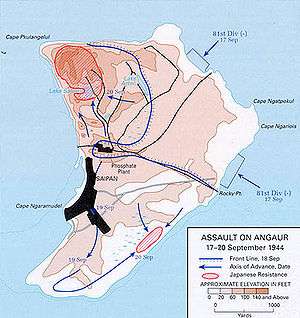Battle of Angaur
| Battle of Angaur | |||||||
|---|---|---|---|---|---|---|---|
| Part of World War II, Pacific War | |||||||
 | |||||||
| |||||||
| Belligerents | |||||||
|
|
| ||||||
| Commanders and leaders | |||||||
|
|
| ||||||
| Units involved | |||||||
|
| ||||||
| Strength | |||||||
| 10,000 | 1,400[1]:89 | ||||||
| Casualties and losses | |||||||
|
260 killed 1,354 wounded[1]:89 |
1,350 killed 50 captured[1]:89 | ||||||

The Battle of Angaur was a battle of the Pacific campaign in World War II, fought on the island of Angaur in the Palau Islands from 17 September—22 October 1944. This battle was part of a larger offensive campaign known as Operation Forager which ran from June 1944 to November 1944 in the Pacific Theater of Operations, and Operation Stalemate II in particular.[1]:16
Background
Angaur is a tiny limestone island, just 3 mi (4.8 km) long, separated from Peleliu by a 7 mi (11 km) strait, from which phosphate was mined.[1]:13 In mid-1944, the Japanese had 1,400 troops on the island, under the overall command of Palau Sector Group commander Lieutenant General Sadae Inoue and under the direct command of Major Goto who was stationed on the island.[1]:39
The weak defenses of the Palaus and the potential for airfield construction made them attractive targets for the Americans after the capture of the Marshall Islands, but a shortage of landing craft meant that operations against the Palaus could not begin until the Mariana Islands were secure.
Once the assault on Peleliu was "well in hand", the 322nd RCT would land on the northern Beach Red, and the 321st RCT on the eastern Beach Blue, both of the 81st Infantry Division.[1]:21
Battle
Bombardment of Angaur by the battleship Tennessee, four cruisers, and forty Douglas SBD Dauntless dive bombers from the aircraft carrier Wasp[1]:68 began on 11 September 1944. Six days later on 17 September, the U.S. 81st Infantry Division—commanded by Major General Paul J. Mueller—landed on the northeast and southeast coasts.[1]:67–68 Both RCTs were counterattacked during the night.[1]:69 Both RCTs linked up the next day.[1]:69 By the end of the third day, 19 Sept., the main area of Japanese resistance was to the northeast around Romauldo Hill, so the 323rd RCT was sent to Ulithi.[1]:70
Resistance stiffened as the Americans advanced on "the Bowl", a hill near Lake Salome in the northwest of the island where the Japanese planned to make their last stand, after the rest of Angaur and Saipan town were taken.[1]:61 There was another small position where the Japanese had about 400 soldiers in a defense at the southeast corner of the island, around Beach Green, that was neutralized on September 20[1]:70 after 2 days of harsh fighting and about 300 U.S. casualties.
From 20 September, the 322nd Infantry Regiment repeatedly attacked the Bowl, but the 750 defenders repulsed them with artillery, mortars, grenades and machine guns. Gradually, hunger, thirst, and American shellfire and bombing took their toll on the Japanese, and by 25 September the Americans had penetrated the Bowl. Rather than fight for possession of the caves, they used bulldozers to seal the entrances. By 30 September, the island was said to be secure although the Japanese still had about 300 more soldiers in the Bowl and surrounding areas that held out for almost four more weeks.[1]:70 Toward the end of the first week of October, 1944, the protracted conflict had degenerated into minor patrol action with sniping, ambushing, and extensive booby-trapping employed by both sides.[2]
The island's defense commander, Major Goto was killed on 19 October[3] fighting to keep possession of a cave.[1]:70–71 The last day of fighting was October 22 with a total of 36 days of fighting and blasting the Japanese resistance from their caves with explosives, tanks, artillery and flamethrowers. The 81 Infantry Division had finally taken the whole of Angaur, albeit suffering more casualties than they had inflicted.[1]:71
Aftermath
Airfields were being constructed as the battle was still being fought, but the delay in the start of the Palaus operation meant that the airfields were not ready in time for the start of the Philippines operations in October 1944. Admiral William F. Halsey, Jr. had argued before the invasion of the Palaus that the operation was unnecessary, and military historians have agreed with him, suggesting that the main benefit was the combat experience gained by the 81st Infantry Division.
During the fighting, Seabees created an airstrip that would house B 24 Liberator bombers of the 494th Bomb Group, 7th Air Force. The group engaged in frequent bombings of the Philippines and other Palau Islands.[1]:91
The 81st Division moved on directly to the battle on Peleliu Island to aid the 1st Marine Division, which had encountered extremely stiff resistance in the central highland of that island. They would remain on Peleliu for another month taking the island and mopping-up.
References
- Morison, Samuel Eliot (1958). Leyte: June 1944 - Jan 1945, vol. 12 of History of United States Naval Operations in World War II. Little, Brown and Company. ISBN 0-316-58317-0.
- Anderson, Charles R. Western Pacific. The U.S. Army Campaigns of World War II. United States Army Center of Military History. CMH Pub 72-29.
- 1 2 3 4 5 6 7 8 9 10 11 12 13 14 15 16 17 18 Moran, J. and Rottman, G.L., 2002, Peleliu 1944, Oxford: Osprey Publishing Ltd., ISBN 1841765120
- ↑ SSgt Edwin "Ed" C Rowold, USMC was killed on Angaur, Palau on 5 Oct 1944. A road on that island was later named for him, according to a letter from his commander.
- ↑ The HyperWar website here, on pages 178 and 179 describes it as "up until the night of the 19th" of October when Major Goto was killed.
External links
- The short film Action at Angaur (1945) is available for free download at the Internet Archive
Coordinates: 6°54′00″N 134°07′59″E / 6.9°N 134.133°E